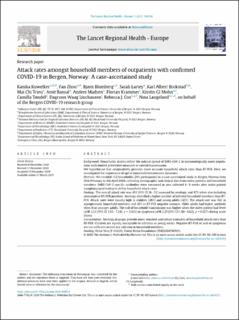| dc.contributor.author | Kuwelker, Kanika | |
| dc.contributor.author | Zhou, Fan | |
| dc.contributor.author | Blomberg, Bjørn | |
| dc.contributor.author | Jalloh, Sarah Larteley Lartey | |
| dc.contributor.author | Brokstad, Karl Albert | |
| dc.contributor.author | Trieu, Mai Chi | |
| dc.contributor.author | Bansal, Amit | |
| dc.contributor.author | Madsen, Anders | |
| dc.contributor.author | Krammer, Florian | |
| dc.contributor.author | Mohn, Kristin Greve-Isdahl | |
| dc.contributor.author | Tøndel, Camilla | |
| dc.contributor.author | Linchausen, Dagrunn Waag | |
| dc.contributor.author | Cox, Rebecca Jane | |
| dc.contributor.author | Langeland, Nina | |
| dc.date.accessioned | 2022-04-06T12:56:48Z | |
| dc.date.available | 2022-04-06T12:56:48Z | |
| dc.date.created | 2021-03-31T08:44:01Z | |
| dc.date.issued | 2021 | |
| dc.identifier.issn | 2666-7762 | |
| dc.identifier.uri | https://hdl.handle.net/11250/2990274 | |
| dc.description.abstract | Background
Households studies reflect the natural spread of SARS-CoV-2 in immunologically naive populations with limited preventive measures to control transmission.
We hypothesise that seropositivity provides more accurate household attack rates than RT-PCR. Here, we investigated the importance of age in household transmission dynamics.
Methods
We enroled 112 households (291 participants) in a case-ascertained study in Bergen, Norway from 28th February to 4th April 2020, collecting demographic and clinical data from index patients and household members. SARS-CoV-2-specific antibodies were measured in sera collected 6–8 weeks after index patient nasopharyngeal testing to define household attack rates.
Findings
The overall attack rate was 45% (95% CI 38–53) assessed by serology, and 47% when also including seronegative RT-PCR positives. Serology identified a higher number of infected household members than RT-PCR. Attack rates were equally high in children (48%) and young adults (42%). The attack rate was 16% in asymptomatic household members and 42% in RT-PCR negative contacts. Older adults had higher antibody titres than younger adults. The risk of household transmission was higher when the index patient had fever (aOR 3.31 [95% CI 1.52–7.24]; p = 0.003) or dyspnoea (aOR 2.25 [95% CI 1.80–4.62]; p = 0.027) during acute illness.
Interpretation
Serological assays provide more sensitive and robust estimates of household attack rates than RT-PCR. Children are equally susceptible to infection as young adults. Negative RT-PCR or lack of symptoms are not sufficient to rule out infection in household members. | en_US |
| dc.language.iso | eng | en_US |
| dc.publisher | Elsevier | en_US |
| dc.rights | Attribution-NonCommercial-NoDerivatives 4.0 Internasjonal | * |
| dc.rights.uri | http://creativecommons.org/licenses/by-nc-nd/4.0/deed.no | * |
| dc.title | Attack rates amongst household members of outpatients with confirmed COVID-19 in Bergen, Norway: A case-ascertained study | en_US |
| dc.type | Journal article | en_US |
| dc.type | Peer reviewed | en_US |
| dc.description.version | publishedVersion | en_US |
| dc.rights.holder | Copyright 2020 The Author(s) | en_US |
| dc.source.articlenumber | 100014 | en_US |
| cristin.ispublished | true | |
| cristin.fulltext | original | |
| cristin.qualitycode | 1 | |
| dc.identifier.doi | 10.1016/j.lanepe.2020.100014 | |
| dc.identifier.cristin | 1901782 | |
| dc.source.journal | The Lancet Regional Health - Europe | en_US |
| dc.identifier.citation | The Lancet Regional Health - Europe. 2021, 3, 100014. | en_US |
| dc.source.volume | 3 | en_US |

